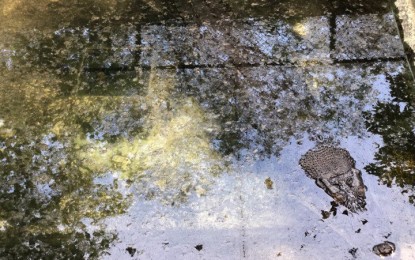
A saltwater crocodile basking in the sun in a pen at the Palawan Wildlife Refuge and Rescue Center in Barangay Irawan, Puerto Princesa City. (File photo by Celeste Anna R. Formoso)
PUERTO PRINCESA CITY, Palawan -- A resident of a remote coastal village in Balabac, southern Palawan, displayed courage over the weekend to save his 15-year old son from the attack of a 15-foot saltwater crocodile by stabbing one of its eyes.
The survivors were identified as Rosmin Mongcong Buara and his son, Karik Asli Buara, of Sitio Dumaga, Barangay Salang, one of the barangays in Balabac that has a known population of estuarine or saltwater crocodiles (Crocodylus porosus).
Both of them sustained wounds. They are now undergoing treatment in a municipal government-run rural health unit (RHU), according to a spot report released Monday by the Palawan Provincial Police Office (PPO).
Investigation showed the incident occurred around 2 p.m. Saturday, May 19, along the shores of Sitio Dumaga.
Karik Asli was said to be catching fish near the riverbank when the crocodile attacked him. His mother, whose name was not mentioned in the report, heard him repeatedly crying for help while being dragged into the water.
She immediately informed her husband Rosmin, who ran towards his son to rescue him and stabbed the crocodile in one eye. Eventually, the reptile let go of the young victim and disappeared, but not before also injuring the father.
Meanwhile, Palawan Council for Sustainable Development Staff (PCSDS) spokesperson Jovic Fabello, who confirmed the attack, said it was good news that the father and son survived.
In an interview, he said that while the eyes of crocodiles are uniquely suited for ambush hunting of preys they are also sensitive when covered or hit with sharp objects because their vision becomes less precise.
“If you will notice in the crocodile farm when they are catching crocodiles, they cover their eyes with clothes to calm them. Their eyes are one of the softest spots of their bodies,” said Fabello.
If the father of the victim suffered injuries or wounds, he explained that they may not be necessarily due to being bitten by the reptile, but by its skin that are bristly and rough to human flesh particularly during a struggle.
He added the attack might also be because of the warmer months when they breed -- from January until end of summer. Some crocodiles also have to adjust breeding patterns depending on their needs which can last until August to September.
“According to our data, crocodile attacks in Salang started in 2010, then in 2014, and now 2018. All the attacks in this barangay are non-fatal, which means those who were attacked survived,” he said.
Proposed crocodile sanctuaries
Fabello said the municipal leadership of Balabac is still assessing the proposal to establish crocodile sanctuaries in at least seven areas to keep residents safe from attacks.
“When we went there last February to present histories of attacks and other details of the proposal, there were officials who are for and against. What’s important here really is ownership of the local government unit (LGU) for the project to be successful. But if they are adamant that the project continues, and they want something else, then we won’t be able to do it in the meantime,” he said.
He added that establishing the crocodile sanctuaries can work to the advantage of the LGU and the communities in the barangays where there are crocodiles.
“Conservation of crocodiles, which is a protected species under the Wildlife Act, is no longer about extracting or getting them out of their natural habitats. If you put them in pens, they might just die. Whereas if they are in their natural habitat, they can survive without you feeding them and they maintain the balance in the wetland ecosystem,” he said.
But in the absence of this, he said what the PCSDS and the Department of Environment and Natural Resources have thought to do is to increase conducting information drives about crocodiles at the community level.
He added they would instead focus on areas in Balabac where there is a presence of crocodile populations.
“In areas that are open to human encroachment, there is a need to put physical barriers. In areas where the crocodiles can’t go across, then there’s no need for physical barriers, only natural is enough, he said.
Fabello said once this is done, both people and the crocodiles can be secured. (PNA)
